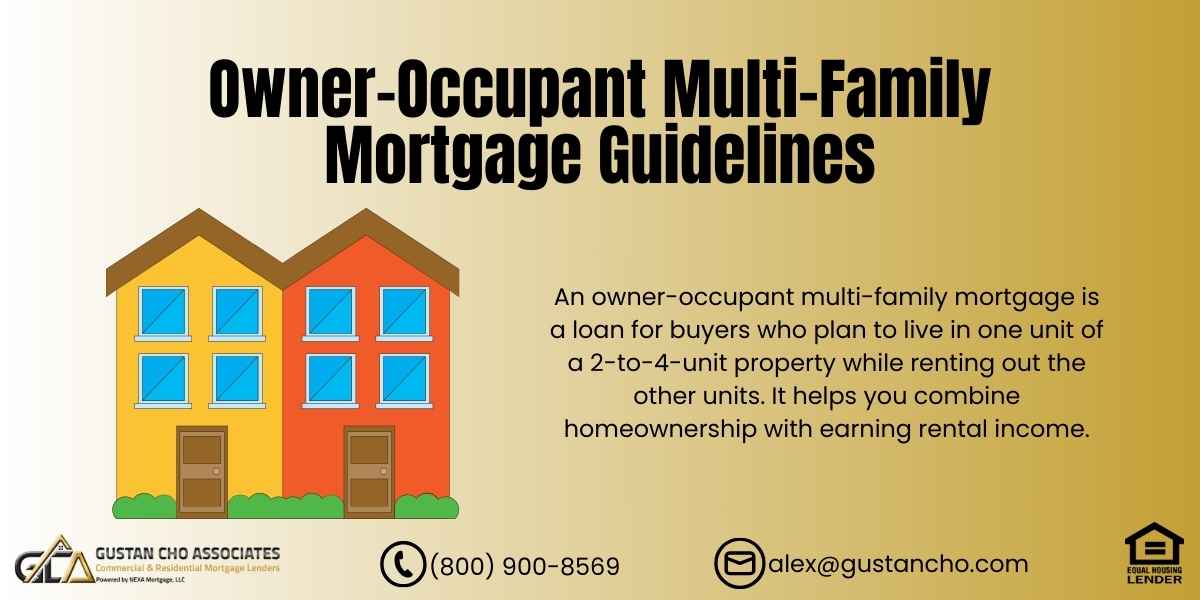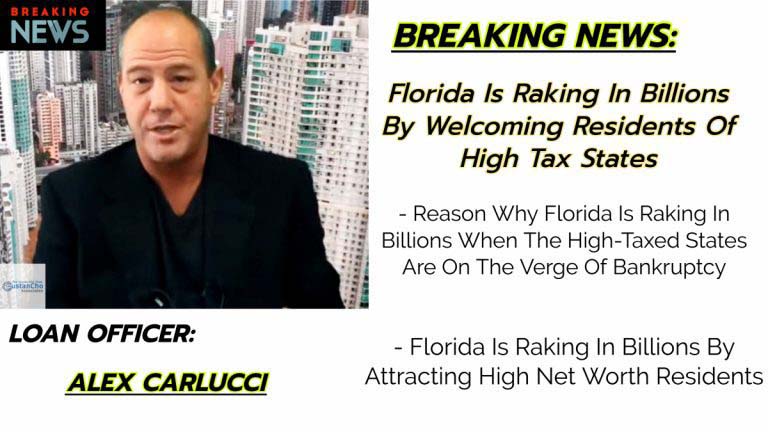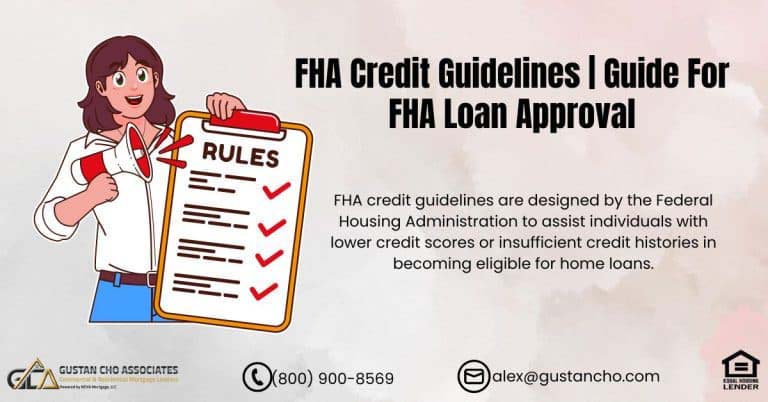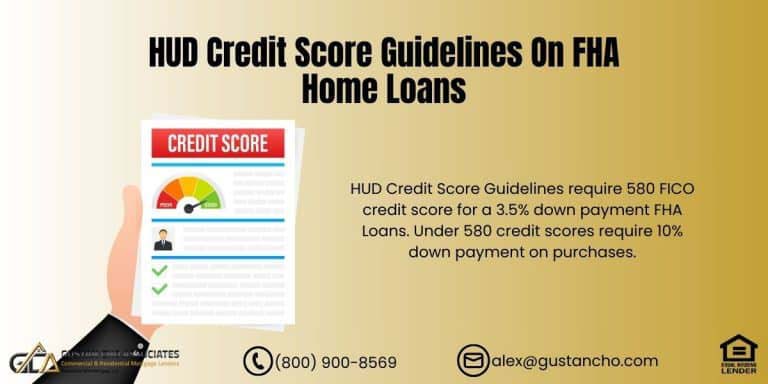Updated Owner-Occupant Multi-Family Mortgage Guidelines for 2025
Are you dreaming of owning a home while earning rental income to help cover your mortgage payments? Buying a 2-to-4-unit property as an owner-occupant might be the perfect solution. With low down payment options, flexible mortgage programs, and the potential to live rent-free, this strategy is an excellent way to start your real estate investment journey.
In this guide, we’ll explain everything you need about owner-occupant multi-family mortgage guidelines in 2025. Whether you are buying your first home or investing again, this post will help you understand your options and get you closer to qualifying for a loan with Gustan Cho Associates.
What Is an Owner-Occupant Multi-Family Mortgage?
An owner-occupant multi-family mortgage is a loan designed for buyers planning to live in one unit of a 2-to-4-unit property while renting out the remaining units. These mortgages allow you to combine homeownership with investment opportunities, offering the following key benefits:
- Rental Income: Use income from the rented units to offset your mortgage payments.
- Low Down Payments: Programs like FHA loans allow down payments as low as 3.5%.
- Equity Building: Your tenants’ rent payments can help you build equity over time.
- Tax Advantages: You may qualify for tax deductions related to mortgage interest, property taxes, and necessary maintenance expenses. Understanding these advantages can significantly enhance your financial outlook.
Apply now for financing tailored to multi-family property owners!
Apply Online And Get recommendations From Loan Experts
Two or Multi-Family Homes Are A Good Investment: Here Are Five Reasons Why
- No Rent Payment: By acquiring a property that includes rental units, homeowners can generate sufficient income to offset their mortgage payments, effectively allowing them to live in the property without personal housing expenses.
- Equitable Shifts: Possessing a property that generates income from multiple units can enhance both financial stability and overall wealth.
- Loans/FHA Advantage: First-time buyers interested in multi-family properties may utilize programs like FHA loans to facilitate their purchase.
Any residential multi-family residential property under HUD Guidelines is a two- to four-unit, zoned residential with no commercial space. If a property has commercial space, it is classified as mix-use, and would not be eligible for FHA loans as per the owner-occupant multi-family mortgage guidelines.
Key Updates for 2025
Mortgage guidelines evolve over time, and staying informed is essential. Here are the most important updates to owner-occupant multi-family mortgage guidelines for 2025:
- FHA Loans:
- The FHA continues to require a minimum down payment of 3.5% for individuals purchasing a home as their primary residence.
- Borrowers are permitted to include up to 90% of the estimated rental income from other units, as determined by the appraiser’s assessment, to meet qualification criteria.
- The requirement for financial reserves continues to be one month for duplexes and three months for triplexes and fourplexes, including principal, interest, taxes, and insurance payments.
- VA Loans:
- VA loans still provide full financing for qualified veterans purchasing properties with two to four units, provided they reside in one of the units
- Conventional Loans:
- Conventional financing options now permit a 5% down payment for owner-occupied duplexes under Freddie Mac’s Home Possible® initiative.
- A 15% down payment is required for 3-to-4-unit properties.
- USDA Loans:
- USDA loans continue to be restricted to single-family residences within specified rural regions, excluding multi-family properties from eligibility.
- Lender Overlays:
- While certain lenders enforce additional criteria, referred to as lender overlays, Gustan Cho Associates does not apply such overlays, thereby simplifying the qualification process.
Explore low down payment options on conforming loans and apply now to get started!
Apply For A Mortgage Loan Today!
How to Qualify for an Owner-Occupant Multi-Family Mortgage
Qualifying for a loan involves several important criteria. Here’s what potential lenders typically examine following the owner-occupancy multi-family mortgage guidelines:
1. Down Payment Requirements
- FHA Loans: FHA loans require a 3.5% minimum down payment.
- Conventional Loans: Conventional loans require a 5% down payment for two-unit properties, 15% for three-unit properties, and between 20% to 25% for four-unit properties.
- VA Loans: VA loans offer 100% financing, eliminating the need for a down payment.
- USDA Loans: USDA loans are not available for multi-family properties.
2. Credit Score
- FHA loans typically require a 580 minimum credit score; however, some lenders may approve scores as low as 500 if accompanied by a larger down payment.
- Conventional loans usually require a credit score exceeding 620.
- While VA loans do not have an official minimum credit score, most lenders prefer applicants to have a score of 620 or higher.
3. Debt-to-Income Ratio (DTI)
The Debt-to-Income Ratio (DTI) measures your monthly debt against your monthly income. Calculate it by dividing your total monthly debt by your gross monthly income. For FHA loans, you can sometimes have a DTI as high as 57%, especially if you include potential rental income.
4. Rental Income
- Up to 90% of the anticipated rental income from additional units can be utilized to qualify for the loan, provided this income is substantiated in the property’s appraisal report.”
- This figure must be documented in the property’s appraisal report.
5. Occupancy Requirement
To secure financing, borrowers must live in one of the units as their main home for at least one year. After this period, they can transition the property into a rental asset, enabling them to buy another residence.
Borrowers will not violate the conditions of HUD if they need to move out of their multi-family residential property after they purchase due to them needing more space due to having a new baby on the way or other extenuating circumstances.
FHA Loans: The Top Choice for First-Time Buyers
FHA loans are an attractive choice for those purchasing their first home, primarily due to the benefits of a minimal down payment and accommodating credit standards. Here’s what you should understand:
- Eligibility: FHA loans are available for 1-to-4-unit properties as long as the buyer occupies one unit.
- Rental Income: Use 90% of appraiser-estimated rental income to qualify.
- Reserves: Reserve requirements are relatively low (1-3 months, depending on the number of units).
Example:
Sarah, a first-time homebuyer, purchases a 3-unit property for $400,000 using an FHA loan. She makes a 3.5% down payment of $14,000 and uses the appraiser’s rental estimate of $1,500 per unit to offset her DTI. Sarah lives in one unit and rents out the other two, covering her mortgage and living rent-free.
Own and invest with just 15% down! Apply now for a conventional loan on 2-to-4 unit owner-occupied properties
Make It Happen With The Perfect Loan And Apply Today!
Conventional Loans: A Flexible Option
Conventional loans offer more flexibility but come with higher down payment requirements:
- Down Payment: As low as 5% for 2-unit properties through Freddie Mac’s Home Possible® program.
- Rental Income: Up to 75% of rental income can be used to qualify.
- Cash-Out Refinancing: Up to 75% loan-to-value (LTV) is available for owner-occupied properties and 70% for investment properties.
VA Loans: A No-Money-Down Solution for Veterans
If you’re a veteran or active-duty service member, VA loans are an incredible benefit:
- Zero Down Payment: VA loans allow 100% financing.
- Multi-Unit Properties: Eligible for 2-to-4-unit homes as long as you occupy one unit.
- No Mortgage Insurance: Save on monthly costs compared to FHA or conventional loans.
Choosing the Right Lender
Not all lenders are created equal. Many impose additional requirements (overlays) that make qualifying harder. At Gustan Cho Associates, we specialize in:
- Loans with no lender overlays.
- Competitive rates for FHA, VA, USDA, and conventional loans.
- Unique programs like bank statement loans and non-QM loans for borrowers with non-traditional income.
Ready to Get Started?
Acquiring a property with 2 to 4 units for personal residence is a savvy strategy for wealth accumulation and ensuring financial stability in the long run. With low down payment options and the ability to leverage rental income, getting started has never been easier. At Gustan Cho Associates, we’re here to guide you every step of the way.
Contact us at 800-900-8569 or email alex@gustancho.com to learn more about owner-occupant multi-family mortgage guidelines and explore your loan options. Let’s make your dream of homeownership and real estate investment a reality!
Apply Online Today!
Don’t wait to secure your dream home and start earning rental income. Apply online now and get personalized recommendations from our team of experts. Whether buying your first home or adding to your investment portfolio, Gustan Cho Associates has the loan program for you.
Frequently Asked Questions About Owner-occupant Multi-Family Mortgage Guidelines:
Q: What is an Owner-Occupant Multi-Family Mortgage?
A: An owner-occupant multi-family mortgage is a loan for buyers who plan to live in one unit of a 2-to-4-unit property while renting out the other units. It helps you combine homeownership with earning rental income.
Q: What are the Benefits of an Owner-Occupant Multi-Family Mortgage?
A: The benefits include rental income to help pay your mortgage, low down payment options, building equity over time, and potential tax savings on mortgage interest and property expenses.
3. How Much Down Payment do I Need for an Owner-Occupant Multi-Family Loan?
A: It depends on the loan type:
- FHA loans: 3.5%
- Conventional loans: 5% for two units, 15% for three units, 20-25% for four units
- VA loans: No down payment
Q: Can I Use Rental Income to Qualify for a Loan?
A: As per the owner-occupant multi-family mortgage guidelines, yes, you can qualify using up to 90% of the appraiser-estimated rental income from additional units. This income must be documented in the appraisal report.
Q: What Credit Score do I Need to Qualify?
A: As stated in the owner-occupant multi-family mortgage guidelines, the credit score requirements are as follows:
- FHA loans: Minimum 580 (sometimes 500 with a larger down payment)
- Conventional loans: Usually above 620
- VA loans: No official minimum, but 620 is preferred by most lenders
Q: What is the Debt-to-Income (DTI) Ratio for These Loans?
A: FHA loans sometimes allow a DTI of up to 57%, especially if rental income is included. Conventional and VA loans usually require lower DTI ratios.
Q: Do I have to Live on the Property?
A: The owner-occupant multi-family mortgage guidelines require you must live in one of the units as your main home for at least one year. After that, you can convert it into a rental property and buy another home.
Q: Are USDA Loans Available for Multi-Family Properties?
A: USDA loans are exclusively designed for single-family residences located in approved rural regions. Multi-family properties are not eligible for this type of financing.Q: Can I get an FHA loan if the property has commercial space?
Q: Can I Get an FHA Loan if the Property has Commercial Space?
A: No, FHA loans are only available for residential properties with 2 to 4 units. Properties with commercial space are classified as mixed-use and are not eligible.
Q: Why Choose Gustan Cho Associates for an Owner-Occupant Multi-Family Mortgage?
A: Gustan Cho Associates offers loans with no lender overlays, competitive rates, and unique programs like FHA, VA, and conventional loans. They specialize in helping buyers qualify easily, even with non-traditional income.
This blog about “Owner-Occupant Multi-Family Mortgage Guidelines”was updated on January 22nd, 2025.











Hi Gustan
I spoke with you and your associates about 8 months ago regarding getting pre-qualified for a VA loan in the state of Tennessee. At the time, my credit report showed some missed payments over the last 12 months due to some private student loans that were inaccurately labeled on credit report.
We should be at a point now where we have nothing missed or later over the last 12 months.
My income is about 110k. I have been with my current company for about 6 years. I have (4) charge off’s on my credit report that goes back to 2016/ 2017
My wife makes about 85k but she just started a new job. same field that she has been working in for many years.
Looking to see if you think you can help us get a pre-qualification letter so that we can make an offer sometime in the Nov -Dec timeframe
Kevin Pendergast